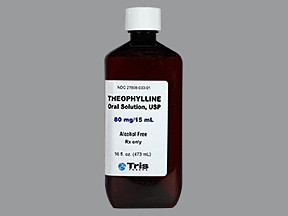THEOPHYLLINE LIQUID - ORAL
PHONETIC PRONUNCIATION: (thee-OF-i-lin)
COMMON BRAND NAME(S): Elixophyllin
GENERIC NAME(S): theophylline anhydrous
Uses
USES: Theophylline is used to treat lung diseases such as asthma and COPD (bronchitis, emphysema). It must be used regularly to prevent wheezing and shortness of breath. This medication belongs to a class of drugs known as xanthines. It works in the airways by relaxing muscles, opening breathing passages, and decreasing the lungs' response to irritants. Controlling symptoms of breathing problems can decrease time lost from work or school. This medication must be used regularly to be effective. It does not work right away and should not be used to relieve sudden breathing problems. If sudden shortness of breath occurs, use your quick-relief inhaler as prescribed.
How to use THEOPHYLLINE LIQUID - ORAL
HOW TO USE: Take this medication by mouth with or without food as directed by your doctor, usually 3 to 4 times daily. If this medicine upsets your stomach, you may take it with food. Measure the dose carefully using a special measuring device/cup. Do not use a household spoon because you may not get the correct dose. The dosage is based on your medical condition, response to treatment, age, weight, lab tests (theophylline blood levels), and other medications you may be taking. Be sure to tell your doctor and pharmacist about all the products you use (including prescription drugs, nonprescription drugs, and herbal products). To reduce your risk of side effects, your doctor may direct you to start this medication at a low dose and gradually increase your dose. Follow your doctor's instructions carefully. Certain diets (such as high protein/low carbohydrate or high carbohydrate/low protein) may change the effect of theophylline. Tell your doctor if you have any major changes in your diet. Your doctor may need to adjust your dose. Take this medication regularly to get the most benefit from it. To help you remember, take it at the same times each day. Keep taking this medication even if you feel well. Do not increase your dose, use this drug more often, or stop using it without first consulting your doctor. Get medical help right away if your asthma symptoms worsen or if you are using your quick-relief inhaler more than usual or more often than prescribed.
Side Effects
Precautions
Interactions
Overdose
Images
Reviews
Faq for THEOPHYLLINE LIQUID - ORAL
Theophylline liquid is used to treat and prevent symptoms of asthma, bronchitis, and other lung diseases. It helps to open airways and improve breathing.
Take theophylline liquid exactly as prescribed by your doctor. Usually, it is taken once or twice daily with or without food. Do not chew or crush the extended-release tablets. Follow the instructions provided by your healthcare professional.
If you miss a dose of theophylline liquid, take it as soon as you remember. However, if it is close to the time for your next dose, skip the missed dose and continue with your regular dosing schedule. Do not double dose to catch up.
Common side effects of theophylline liquid may include nausea, vomiting, headache, stomach pain, diarrhea, and increased or irregular heartbeat. Contact your doctor if these side effects persist or worsen.
It is recommended to limit intake of caffeine-containing products, such as coffee, tea, soda, and chocolate, as they can increase the effects and side effects of theophylline. Talk to your doctor about any dietary restrictions while taking the medication.
Theophylline liquid may interact with other medications, including antibiotics, antifungal drugs, certain antidepressants, seizure medications, and others. It is important to inform your doctor about all the medications you are taking to avoid potential interactions.
Theophylline liquid starts working within 30 minutes to 2 hours after taking it orally. However, the full effects may take several days or weeks to be noticeable. It is important to continue taking the medication as prescribed by your doctor.
Yes, theophylline liquid can be prescribed for children to treat certain respiratory conditions. However, the dosage and administration should be determined by a pediatrician based on the child's age, weight, and overall health.
Pregnant or breastfeeding women should consult their doctor before taking theophylline liquid. The medication may pass into breast milk and may harm a nursing baby. The potential risks and benefits should be discussed with a healthcare professional.
If you suspect an overdose of theophylline liquid, seek immediate medical attention or contact a poison control center. Symptoms of overdose may include confusion, seizures, severe nausea/vomiting, rapid or irregular heartbeat, and trouble breathing.
Disclaimer
IMPORTANT: HOW TO USE THIS INFORMATION: This is a summary and does NOT have all possible information about this product. This information does not assure that this product is safe, effective, or appropriate for you. This information is not individual medical advice and does not substitute for the advice of your health care professional. Always ask your health care professional for complete information about this product and your specific health needs.



No Reviews Yet